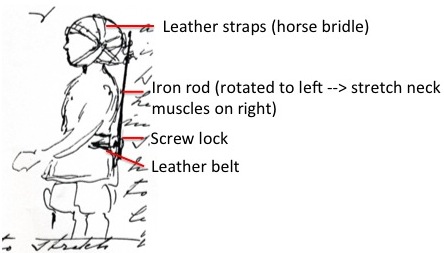A group of nerves formed from vertebral levels C4-T1 in the spinal cord that are responsible for innervating most of the structures in the upper limb (see figure below). The majority of brachial plexus injuries occur during delivery through the birth canal. Most newborns with such injuries are larger than average at birth, although the damage can happen even with preterm infants. The injury can be a consequence of the newborn’s shoulder becoming impacted, resulting in the brachial nerves being stretched or torn (referred to as shoulder dystocia), and possibly Erb-Duchenne palsy (sometimes referred to as pediatric brachial palsy in children). It occurs in about 2 in 1,000 newborns, with about 1 in 10 requiring surgical treatment. One of the best known victims is Kaiser Willem II (1859-1941). One of the treatments he was subjected to is depicted the other figure below.

